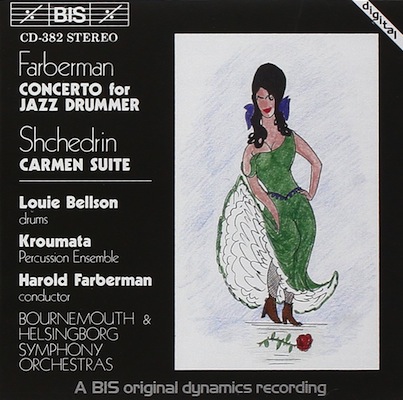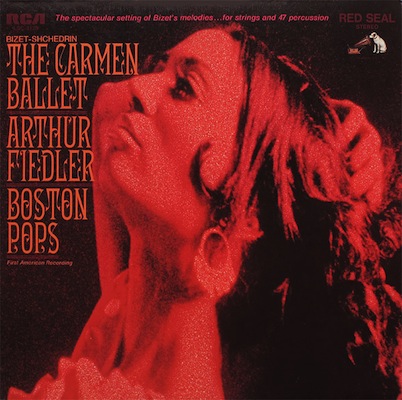
Rodion Shchedrin: “Carmen-Suite,” after Bizet

Rodion Shchedrin: Carmen-Suite for strings and 47 percussion instruments, after Bizet (written 1967)
CD BIS 382 (recorded 1987)
(No high-resolution download available, apparently.)
Kroumata Percussion Ensemble, Helsingborg Symphony Orchestra, Howard Faberman, conductor; Robert von Bahr, producer; Siegbert Ernst, engineer.
Talk about a Guilty Pleasure. An email from Jason McCrary of Reference Audio (one of my Esperanto Audio dealers) finally made me sit down and listen all the way through Rodion Shchedrin’s Carmen-Suite, from the 1967 Alberto Alonso ballet. An LP-loving (and vacuum-tube-loving) customer had turned Jason on to the EMI LP with Gennady Rozhdestvensky and the Bolshoi Theatre Orchestra. The original of that LP is out of print. According to the LP-sales database Popsike, it has fetched between $21 and $142 used, with a median of $48, and a mean of $54. There is (or was) a 180-gram LP reissue (at least in Germany and Switzerland).
The guilty-pleasure aspects of Shchedrin’s score are first the orchestration—strings only, plus four percussionists playing a total of 47 different percussion instruments (to give that word a very wide scope)—while the other guilty pleasure is the affectionate cheekiness of Shchedrin’s musical tamperings.The opening is as good an example as any. After a brief string introduction, chimes begin slowly to pick out the theme of the famous Habanera song (“L’amour est un oiseau rebelle”), but the chimes stop dead before finishing the first phrase. The next phrase is cut off even more abruptly. And so on.
Mvmt. 1, Introduction.
Shchedrin is toying with the audience’s expectation of hearing familiar phrases in full. Later on, he plays melodies against each other to create new counterpoint, changes chords and harmonies, etc. To sum up in one phrase: Schnittke-like clever showing off.
Alonso’s ballet was yanked off the stage by the Soviet cultural authorities for two reasons. One, the eroticized action of the ballet made Carmen appear, at least to the Soviet commissars, to be a tramp (I guess Carmen was supposed to be a virtuous sexless proletarian whose only dreams were of World Revolution). And, Shchedrin’s good-natured but admittedly sly musical tweakings were judged to be “disrespectful.” (Who knew that the Communists cared about Bizet? Or about Fascist Spain?) Only the personal intervention of Shostakovich allowed additional performances of the ballet to take place.

The ballet score in suite form took on a life of its own on LP record, with the above-mentioned Bolshoi LP in the same record-store bin as the Arthur Fiedler Boston Pops version. And the score is a treat. I bet that hi-fi-show exhibitors of today would get lots of attention by adding a few tracks from Shchedrin’s Carmen-Suite to their show-demo-music playlists.
The CD I obtained (from distributor Naxos–thanks!) is on Sweden’s BIS label. It was recorded in 1987 using as far as I can tell first-generation Sony digital gear, so, the sound does not strike me as being as vivid and transparent as BIS’ recent work. But this is a rather rare work—I have not been able to find a version recorded in this century. How strange to write that. Fear not, BIS’ 1987 CD sound is totally acceptable. The spatial renderings of all the percussion goings-on are very impressive.
Here are sound samples of the Habanera, a Scene, and a heart-on-sleeve, almost Mahlerian Adagio.
Mvmt. 5, pt. 2, Habanera.
Mvmt. 6, Scene.
Mvmt. 11, Adagio.
The companion piece on this BIS CD is Faberman’s Concerto for Jazz Drummer, written for Louie Bellson. (Cue up drum-solo jokes.) For me it was mostly a take-it-or-leave-it experience, except for the third movement, which is jazzy in a lighthearted 1920s way.
LP lovers will want to find an LP. There does not appear to be a hi-res digital download. So the main choices (apart from streaming) are the BIS CD (which is a bit pricey, as it is an import), the Delos recording, which on a brief Steinway Streaming listen sounds fine, or, the budget-priced Naxos release, which also sounded fine.
You can also find DVDs of the ballet. BTW, it was Shchedrin’s wife, the ballerina Maya Plisetskaya, who started out by asking mutual friend Dmitri Shostakovich for a Carmen ballet score. Shostakovich replied along the lines of, “Don’t you live with a composer?”
# # #



For those looking for instant gratification — the Shchedrin recording can be downloaded directly from the BIS website: http://www.eclassical.com/composers/shchedrin-rodion-konstantinovich/shchedrin-carmen-suite-concerto-for-orchestra.html
Thanks, Steve.
This provides an opportunity for me to explain that I do not consider a “CD Quality” download to be a “high resolution” download. And there is not likely to be a hi-res download of this program, unless there were analog safety tapes made at the same time as the 16-bit digital, and those analog tapes were preserved and eventually edited and given new hi-res transfers.
John Marks